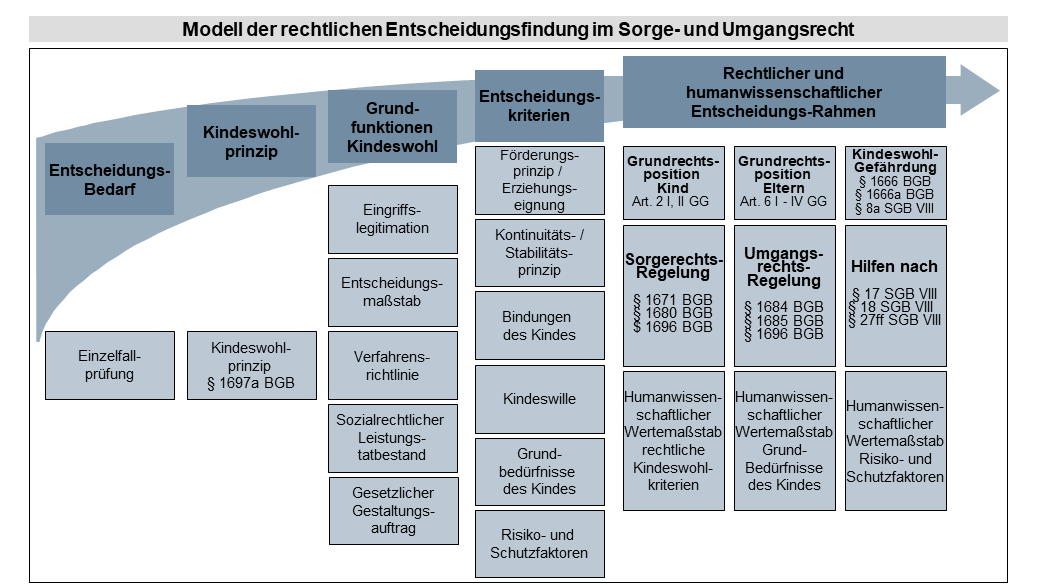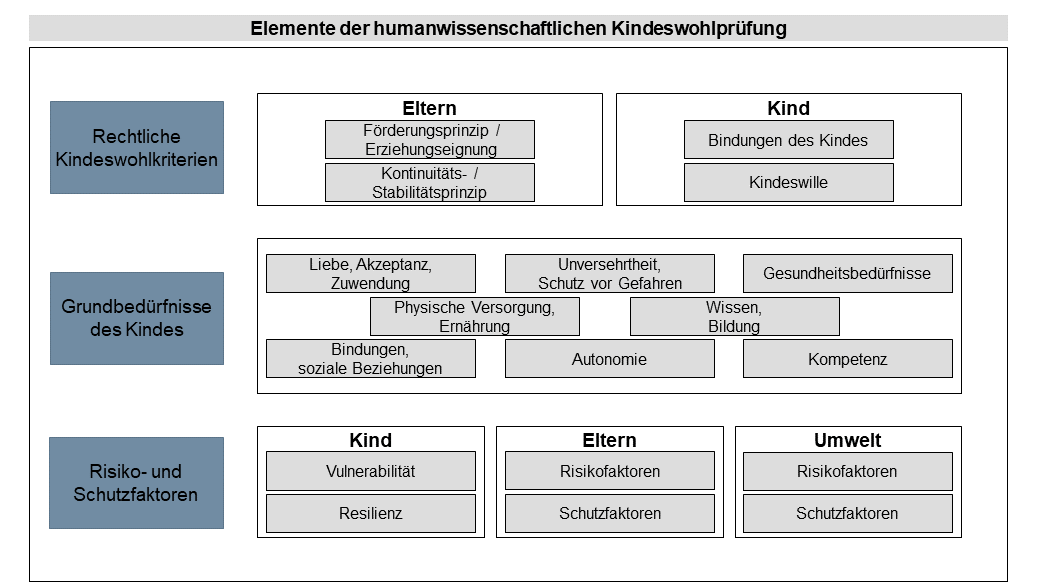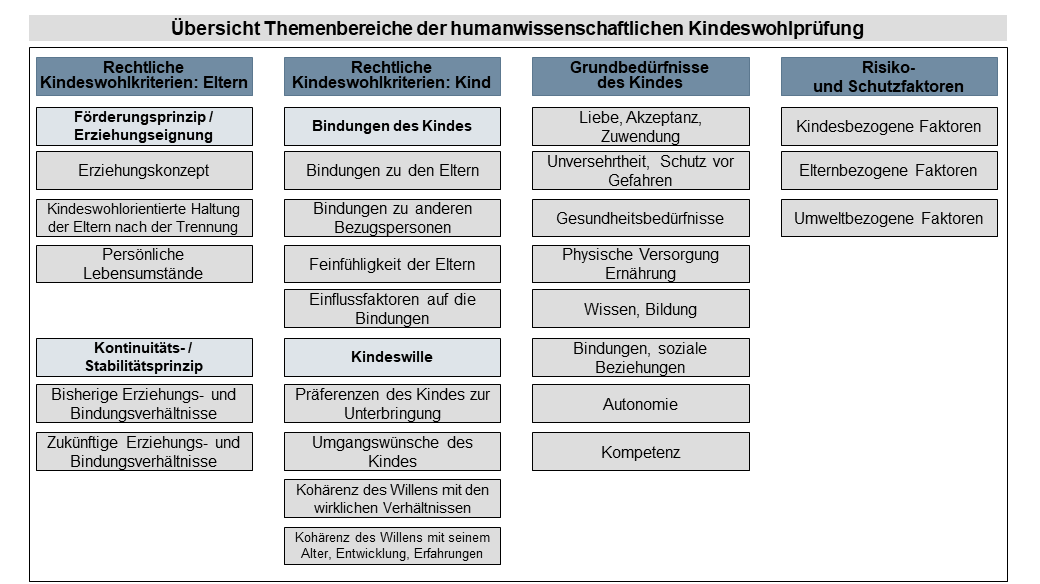1.
Areas – selection
- Questions about parental care in the event of separation and divorce
- Regulation of how the child interacts with the parents
- Regulation of how the child interacts with other caregivers
- Questions about child welfare risk
- Questions in the event of failure of the parents or one of the parents
- Psychological questions to assess the impact of risk and protective conditions on the child
2.
Approach to the preparation of the expert opinion
Approach:
Our diagnostic work is decision-oriented and development-oriented.
When diagnosing, we align ourselves with the client’s question in order to prepare and support a decision. However, we also see the chances of a solution-oriented (independent of an explicit assignment according to § 163 Abs 2 FamFG) and development-oriented (intervention-oriented diagnostics) counceling to motivate the parents to cooperate and to get involved in a change process by considering the situation and the needs of the affected child (unification requirement – § 156 Abs 1 FamFG).
Even with the solution-oriented approach, the speed-up requirement of § 155 FamFG must be observed in any case in order to create legal protection, to do justice to the child’s sense of time and not to create irreversible facts. That is why we prepare expert reports within three months of being commissioned by a court.
3.
Content of the preparation of the report
Figure 1 shows the model of legal decision-making in custody and access law.

Figure 1: Model of legal decision-making in custody and access law
On this basis, we examine the legal child welfare criteria that affect the parents, the legal child welfare criteria that affect the children, the basic needs of the child and risk and protective factors of the child, the parents and the environment as elements of the human-scientific child welfare assessment. Figure 2 shows the elements of our human-scientific child welfare assessment.

Figure 2: Elements of the human-scientific child welfare assessment
Figure 3 contains an overview of the subject areas that should be evaluated in the named examination proceedings.

Figure 3: Overview of subject areas of the human-scientific child welfare assessment
For each subject area, questions can be derived from the results of the human sciences, which can be used for consensus, on the basis of which an individual case can be analyzed and evaluated.
4.
Structure of the preparation of the report
Structure:
Front page
Table of contents
Details of the people involved
- Question (s) of the client
- File analysis from a psychological point of view
- Psychological questions (hypotheses)
- Investigation methods: Description of the procedures and justification for their use in the present individual case
- Results
- Psychological findings: combination and weighting of the individual results. Answering the psychological questions and thus the questions posed by the client (diagnostic assessment)
- If required: Suggestions for problem solving or recommendations for further action; possible results of (rudimentary) attempts at problem solving (intervention)
- Date, signature (s)
- Appendix: Bibliography, possibly: tables with summarized test results, possibly: additional reports, possibly: other documents
5.
Partially standardized procedures
Most of the questions cannot be answered by standardized psychological procedures, but by the partially standardized procedures, especially the diagnostic interviews and behavioral observation.
Diagnostic decision-oriented discussions:
We pursue the approach of decision-oriented conversation, in which the processing of a diagnostic question is planned, carried out and evaluated according to the criteria of psychological science. The goal of decision-oriented discussions is to collect the information that is useful for making satisfactory decisions as completely and undistorted as possible. This means that all the necessary individual considerations flow into a detailed guide for the court. The guidelines for decision-oriented discussions are geared towards the question and the psychological questions derived from it, based on secured requirements, geared towards the relationship between costs and benefits and designed to be practicable.
Behavioral observation:
For many questions it is absolutely necessary to observe the test persons in their natural environment. We also plan observations in the natural environment as far as possible according to the criteria Who? (Type of observer) What? (Content of the observation), when? (Period of observation) How? (Type of observation). As a rule, the focus of the behavioral observation is on the interaction observation of the family members with one another.
6.
Standardized diagnostic procedures
The standardized procedures include tests, questionnaires and standardized behavioral observation. Test procedures form the bridge to get into conversation and information relevant to decision-making. In the context of method triangulation, the data obtained in this way can provide support in classifying information, but they never replace a conversation. They are used with the greatest possible thrift; in particular, they are only used when other, interaction-oriented methods are not suitable for collecting the desired information, which may only serve the psychological questions to be answered. If test procedures are used, their significance for the expert opinion and the type of information collected are explained to the “test person” beforehand in order to ensure acceptance of the expert’s approach.
7.
Guidelines for preparing psychological reports
Reports prepared according to our proposals correspond to the “Guidelines for the preparation of psychological reports” of the Federation of German Psychological Associations (1994) as well as the “Guidelines for the Assessment Process” of the European Association of Psychological Assessment (EAPA), which have been published in German as “Richtlinien für den diagnostischen Prozess”. We develop our own reports using the procedure of Univ.-Prof. Dr. Karl Westhoff and Univ.-Prof. Dr. Marie-Luise Kluck (Westhoff, K. & Kluck, M.-L., 2014, Psychologische Gutachten schreiben und beurteilen, 6. vollständig überarbeitete und erweiterte Auflage, Berlin: Springer).
8.
Literature
Schmidt, A. & Westhoff, K. (2020). Kindeswohl interdisziplinär: Empirische Ergebnisse für die juristische Praxis bei Trennung der Eltern. Baden-Baden: Nomos.
Westhoff, K. & Kluck, M.-L. (2014). Psychologische Gutachten schreiben und beurteilen (6. vollständig überarbeitete und erweiterte Auflage). Berlin: Springer.
9.
Contact
Univ.-Prof. Dr. Karl-Josef Kluge
(University of Cologne, Faculty of Human Sciences, Department for Curative Education and Rehabilitation, Subject: Educational Aid and Social-Emotional Promotion)
Phone:
02162 24606
E-Mail:
klugekajo@yahoo.de und kluge@euroges.de
Dr. Axel Schmidt
(Diploma in business administration, diploma psychologist)
Phone:
0171 307 39 48
E-Mail:
axel.schmidt@familiengutachten.eu

